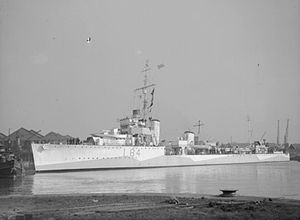 HMS Keppel, in 1943
| |
| History | |
|---|---|
| Name | HMS Keppel |
| Namesake | Augustus Keppel |
| Ordered | April 1918 |
| Builder | John I. Thornycroft & Company |
| Yard number | 982 |
| Laid down | October 1918[1] |
| Launched | 23 April 1920[1] |
| Commissioned | 15 April 1925[1] |
| Recommissioned | August 1939 |
| Fate | Discarded 1945, Scrapped [2] |
| General characteristics [1] | |
| Class and type | Thornycroft type destroyer leader |
| Displacement |
|
| Length | |
| Beam | 31 ft 6 in (9.60 m) |
| Draught | 12 ft 3 in (3.73 m) |
| Installed power | 40,000 shp (30,000 kW) |
| Propulsion |
|
| Speed | 38 kn (44 mph; 70 km/h) |
| Capacity | 500 short tons (450 t) fuel oil |
| Complement | 164 |
| Armament | 5 × BL 4.7 in (120 mm) Mark I dual purpose gun, 1 × QF 3 inch 20 cwt anti-aircraft gun,[2] 6 × 21 inch (533 mm) torpedo tubes (2 × 3) |
| Service record | |
HMS Keppel was a Thornycroft type flotilla leader built for the Royal Navy at the end of the First World War. She was completed too late to serve in that conflict, but saw extensive service in the inter war years and in World War II. She was an effective convoy escort and U-boat killer, being credited with the destruction of five U-boats during the Battle of the Atlantic. She was the second of three ships named for 18th century Admiral Augustus Keppel.